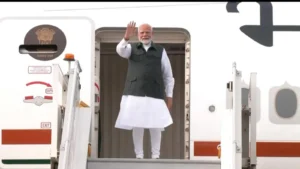Politics
PM Modi Brunei and Singapore Visits Enhance ASEAN Focus in Third Term
PM Modi Brunei and Singapore Visits Enhance ASEAN Focus in Third Term
Prime Minister Narendra Modi latest round of diplomacy underlines an increased pace of engagement with ASEAN as part of the Act East Policy on its 10th anniversary year. Greater intensity introduced by Modi reflects a strategic emphasis on strengthening relations with ASEAN countries-a region very important to India’s foreign policy outlook.
After substantive engagements with the Prime Ministers of Vietnam and Malaysia, the successful recent visits to Brunei and Singapore represent a new phase of this policy. A proposed visit to Thailand fell through due to a change of government there and the postponement of the BIMSTEC Summit, but Modi went ahead with his engagements in Brunei and Singapore, underlining his intent to maintain the momentum in ASEAN relations during his third term.
The visit to Brunei was of particular historic significance. This is the first bilateral visit by an Indian Prime Minister since Brunei’s independence in 1984 and the establishment of diplomatic relations in 1992. It was not an accident that the timing coincided with the 40th anniversary of these relations. Indeed, this visit took the India-Brunei relationship to a new plane when it was termed as an ‘Enhanced Partnership’ implying deeper and wider engagement in a host of areas such as trade, energy, space, and capacity building. One important outcome, which showed that this was, indeed, a strategic partnership, was the Brunei site for a satellite tracking station so critical for India’s space programme.

If the visit was imperative for Australia, Modi’s visit to Singapore was no less historic as he came to the city-state for the first time during his third term. The visit elevated their bilateral relationship to a Comprehensive Strategic Partnership as India and Singapore are going to celebrate 60 years of diplomatic relations next year. Modi’s engagement with Singapore was particularly significant since his powerful 2018 Shangri-La Dialogue speech laid out India’s Indo-Pacific policy. This visit was highly anticipated because he had not come to Singapore during his second term.
During his visit to Singapore, Modi called on the new Prime Minister Lawrence Wong and two former prime ministers with whom India has enjoyed close relations. Singapore has been the country coordinator for India in ASEAN for the last three years and was a guest at the G20 summit in 2023. This was therefore a politically important visit underlining Singapore’s central role in the ASEAN region and its confluence with India’s strategic priorities.
The meetings underlined the shared determination for furthering human, cultural, and spiritual connect between the two countries. Modi appreciated the Singapore multiculturalism that has integrated all communities, including the Indian diaspora, into one. External Affairs Minister S. Jaishankar highlighted some of the key aspects of the visit, which included a tour of a semiconductor testing facility and an agreement on a Thiruvalluvar Centre, representing both modern and traditional dimensions of engagement with Singapore.
More recently, the Singaporean leadership and business community has developed an increasing appreciation of growth potential in India and recent economic reforms. This eagerness for deeper cooperation is a positive perceptual shift, and which included a high-level ‘4X4’ ministerial engagement now known formally as the India-Singapore Ministerial Roundtable or ISMR.
The Indian side was represented by ministers of finance, external affairs, commerce, industry, IT, and railways, while the Singaporean team was led by a Deputy Prime Minister-led delegation in charge of finance, foreign affairs, home affairs, law, and digital development.
The ISMR marked out six pillars for bilateral cooperation, with the addition of advanced manufacturing and connectivity as new areas. This ambitious plan speaks to a wide-ranging agenda of issues to be addressed, including those impacting the Indian diaspora in Singapore.
For India, Singapore has been one of the most consistent partners in the region and an important player in its economic exchanges-90 percent of investment flows between India and ASEAN are through Singapore. Often, the city-state has acted as a conduit for Indian companies into broader regional markets, though rising costs have pushed many lately onto other more substantial markets such as Indonesia and Malaysia.
These include the four key MOUs signed on digital technologies, semiconductors, health cooperation, and skill development. Of these, perhaps the semiconductor agreement is most critical. Singapore has emerged as a global leader in chipmaking and will now support India’s ambition of ramping up its semiconductor manufacturing. This is going to be extremely significant because Singapore accounts for 10 percent of global chip production and 20 percent of semiconductor-related production.
Analysts in Singapore have long been disappointed by the unrealized potential in India against that presented by China. But the post-pandemic era has reversed this trend as Singaporean thought leaders take note of the limits on the Chinese opportunity and the constraints to Singapore’s access to the Chinese market. It is an upbeat perception concerning India as one of the major growth leaders among the economies.
Also Read: ED Raids Former RG Kar Principal Sandip Ghosh Residence in Financial Misappropriation Case
Continued reforms and a growth trajectory have made India an attractive partner for Singapore that seeks to engage more meaningfully with the development story of India. The approach of India is not to present Singapore with the Hobson’s choice of choosing between India and China, but to provide an opportunity for valuable collaboration which is in alignment with the broader strategy of Singapore for diversification of its supply chains, as reflected in the “China plus one” strategy.
Strategic hedging on its relationship with China remains currently the approach of Singapore. In the joint statement during Modi’s visit, the South China Sea was mentioned and it had called for a code of conduct that was fair and in keeping with UNCLOS. For the first time, an ASEAN country officially acknowledged the role of the Quad while appreciating support for centrality for ASEAN and the Indo-Pacific agenda.
All in all, this stretched the India-Singapore bond into a qualitatively new phase in their bilateral relations-one that is concentrated on modernism and dynamism, complementing India’s development processes beyond conventional ASEAN principles.












